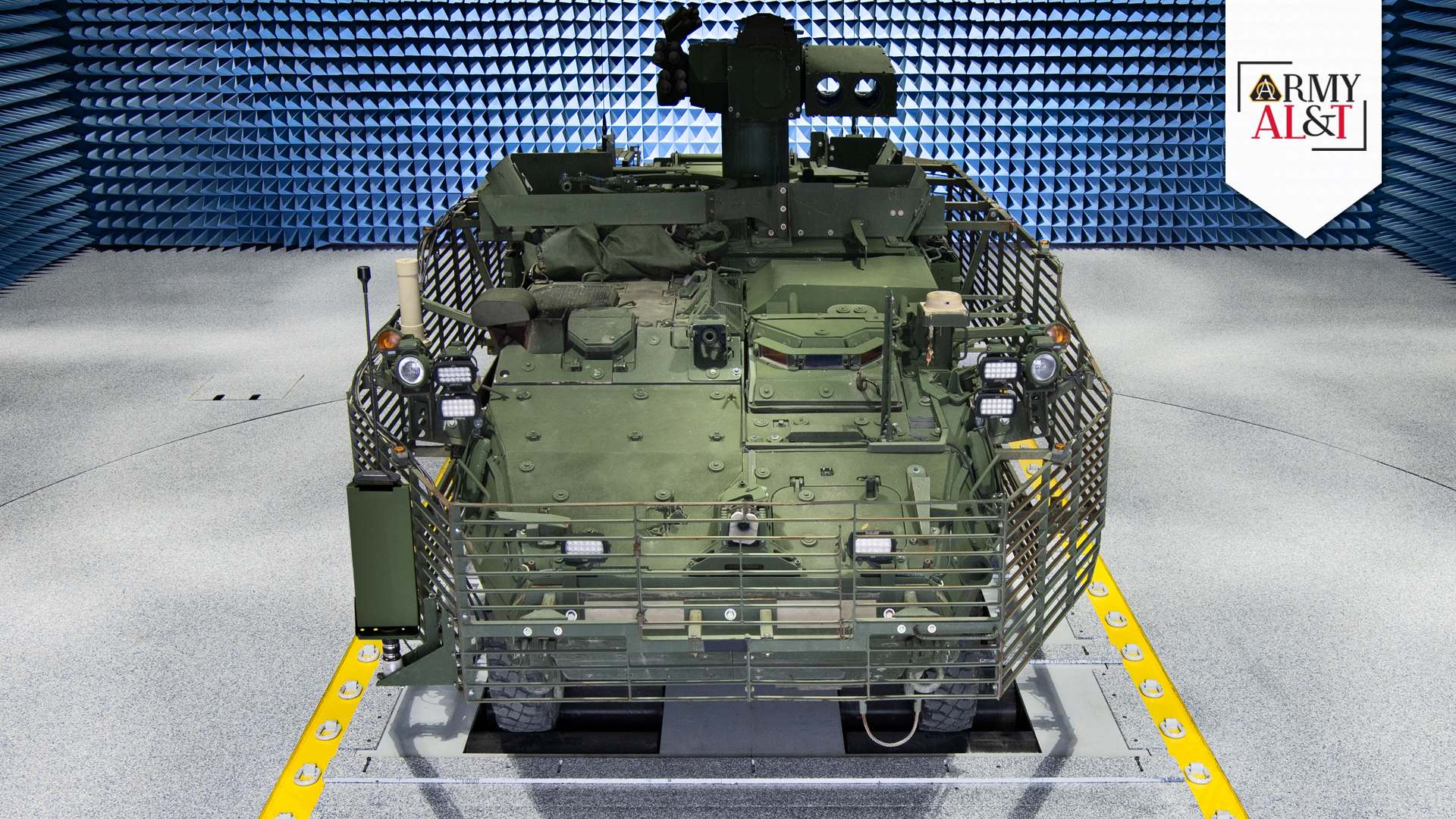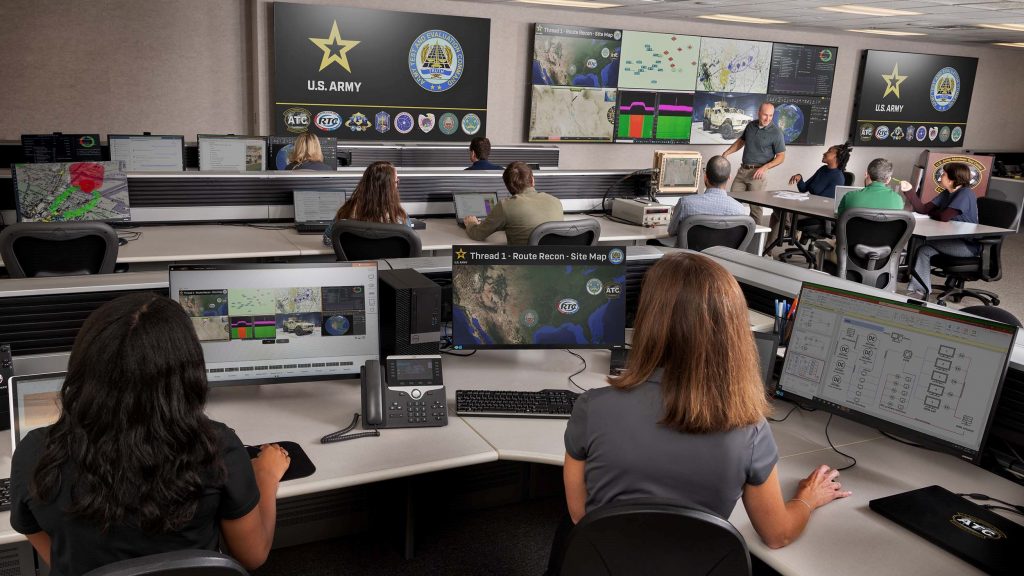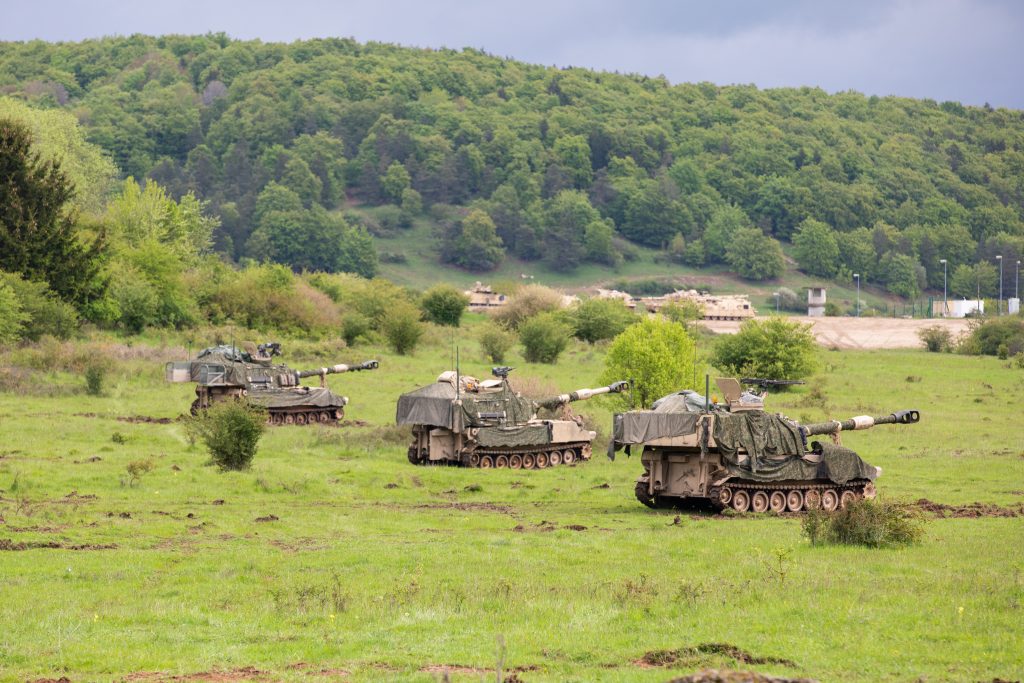
PASSING THE TEST: Aberdeen Test Center’s electromagnetic environmental effects dynamometer with built-in turntable is the only one of its kind across DOD. It is engineered to test the effectiveness of wheeled vehicles in congested and contested radio frequency environments. (Photo by Steven Lowther, Aberdeen Test Center)
U.S. Army Test and Evaluation Command launches virtual environment to evaluate systems in multidomain operations.
by Rebecca Wright
The U.S. Army is known for protecting our nation predominantly on land. But as our adversaries’ capabilities advance, so must the Army’s abilities to predict, counter and, if necessary, defeat them. Focusing mainly on proficiency in one or two domains can limit the Army’s ability to advance in support of the joint force. Potential adversarial threats—primarily posed by (but not limited to) China and Russia—call for the Army, as part of the joint force, to continuously transform to operate in all domains on a future battlefield. This means not only having specialized experience on the ground, but across all domains holistically.
In December 2018, the Army published “The U.S. Army in Multi-Domain Operations 2028,” which outlines the importance of maintaining a position of superiority and how to win future conflicts. According to the U.S. Army’s Field Manual 3-0, “multidomain operations are the combined arms employment of joint and Army capabilities to create and exploit relative advantages that achieve objectives, defeat enemy forces and consolidate gains on behalf of joint force commanders. Employing Army and joint capabilities makes use of all available combat power from each domain to accomplish missions at least cost.” In essence, multidomain operations are an effort that the Army, as part of the joint force, is undertaking to expand frontline operations and expertise across all domains and synchronize them across an interconnected and uncertain operating environment.
THE DOMAIN IN MULTIDOMAIN
For the U.S. and its allies to maintain dominance, warfighters must remain ready to engage across the competition continuum. Current Army doctrine identifies five key areas covered in multidomain operations: land, air, maritime, space and cyberspace. Potential adversaries are challenging these areas and competing for dominance across the multidomain environment. Space and cyberspace operations have not always been at the forefront within the Army, but are becoming increasingly important.
“There are specific departments of the DOD that are our specialists in those areas: the Air Force, the Navy, cyber and even Space Force,” said Col. Rashad Fulcher, senior simulations officer with the U.S. Army Operational Test Command. “In order to fully round out a true MDO [multidomain operations] environment, I think that we absolutely need to conduct joint testing or at least have joint representation in our operational testing. It’s important to the Army because of our current and future threats. As we see world events in current conflicts … people are targeting electronic signals. The electronic environment is a concern for us, and we need to be ahead of that threat.”
For example, in a potential combat scenario the Army will secure terrain with armored vehicles and ground forces while coordinating with Air Force-operated fighter jets and Navy-operated ships, all while using space satellites to track and monitor the location of the threats and using cyberspace communications to exploit and disrupt the enemy’s technology.

RANGE OF COMMUNICATION: The Distributed Test Control Center can link two or more ranges across multilevel security networks to create an integrated test environment. The capability is used to assess system performance and effectiveness against real and simulated threats in an operationally relevant LVC environment. (Photo by Steven Lowther, Aberdeen Test Center)
TESTING THE WATERS … AND LAND, AIR AND CYBERSPACE
While stressing the importance of multidomain operations is easy, experimenting, testing and training to operate in a multidomain environment is a different story. It comes as no surprise that live, physical testing and training is costly and potentially hazardous. In October 2023, to address the Army’s need to prepare for future dominance, the U.S. Army Test and Evaluation Command (ATEC) conducted multidomain operations in a test environment that included live, virtual and constructive (LVC) simulations. The demonstration, conducted in Maryland at Aberdeen Proving Ground, networked capabilities from all eight ATEC locations throughout the U.S. to successfully test operational scenarios in the land, air, space and cyberspace domains. In addition to testing, the LVC environment can enable experimentation and training opportunities that are not only realistic but allow testing of systems, concepts, formations and forms of maneuver that would otherwise be too costly or impractical to perform in a live environment.
“We created an operationally relevant learning environment by connecting a number of test facilities from across the country through an innovative test network provided by the Test Resource Management Center,” said Paul Weimer, a supervisory engineer at the U.S. Army Aberdeen Test Center, a subordinate of ATEC. “To achieve the scale commensurate of an MDO environment, the physical test capabilities were integrated and synchronized with virtual systems using the LVC construct.”
Weimer explained that the live, virtual and constructive environment enables experimentation with new scenarios that could not be tested and evaluated in live-only or virtual-only settings. These scenarios test the user and the materiel solutions in real time and provide additional data that enables users to be better prepared if a similar scenario occurs in a tactical environment. “In order to get to an operational level of scale, we need to supplement the live assets with virtual assets in a way that the user is unable to tell whether the system is live or virtual,” he said. “The systems in the LVC environment respond in the same manner as the systems in the real-world environment, which allows us to build up the scale of the experiment, test or exercise. Using LVC, we’re now getting after an operationally realistic, scaled MDO environment.”
Weimer described one of the threads demonstrated at the October 2023 event. A live, fielded tactical vehicle was placed in an electromagnetic interference (EMI) chamber, a controlled environment used to test radio frequency emissions, susceptibilities and interference. While in the chamber, the tactical vehicle was secured to a dynamometer, a device that measures torque and engine power and enables a vehicle to operate in different driving conditions.
During the demonstration, an operator used throttle and steering input inside the vehicle to drive while it was secured to the dynamometer. In a feedback loop, the vehicle’s steering and engine output were measured on the dynamometer and returned to the simulated test environment, changing the simulation output. The live tactical vehicle could be seen moving in the simulated scene and the movement drove changes with live or virtual threats or entities in the simulation.
“In this thread we demonstrated an electronic warfare attack on the vehicle to see how it would impact the convoy. Using a live jammer in the EMI chamber, we jammed the tactical vehicle’s fielded GPS and radio systems. Then, you could see in the simulation where the live vehicle lost contact with the simulated convoy. The live vehicle was no longer visible on the tactical screens and the operator driving the system lost situational awareness of their position,” Weimer said. “The objective of the test was to measure the time for the operator to regain situational awareness and communication with the convoy. I think it is important to be able to see the effect of a threat beyond just the effect on an individual system. In traditional developmental testing, my focus would just be the effects on the live system in the chamber, but with the LVC environment we were able to see the effects on the live vehicle and how that effect impacted the overall tactical operation. We can now learn the broader impacts of that electronic warfare attack on the entire formation and operation.”

MISSION ACCOMPLISHED: Paladin howitzers prepare to receive a fire mission during exercise Combined Resolve 18, held in May 2023 in Hohenfels, Germany. The exercise included more than 4,000 service members, allies and partners from 15 countries, and was designed to assess units’ abilities to conduct combat operations in a multidomain battlespace. (Photo by Spc. Casandra B. Ancheta, 117th Mobile Public Affairs Detachment (Hawaii))
JOINT FORCE PLANS
Operating as a joint force within the military is nothing new, but doing it seamlessly, in all domains, is a new challenge. ATEC’s ability to simultaneously test with both live and virtual assets while providing real-time data and results gives the Army a leading edge in experimentation, training and testing. “We’ve always been able to do live testing, virtual [only] testing, and use simulations to provide some results or some statistics for single systems, but the most powerful thing about LVC is the increased scale of the test environment and the ability to measure the interactions and interoperability of systems,” Weimer said. “Now we can have Soldiers that are included in this environment communicating with these assets and see how they respond when another member of the formation is hit with an electronic warfare attack. We can see how the formation responds in an operationally relevant environment and use that information to inform material system improvements, leader development, training, tactics and procedures.”
Weimer added that the live, virtual and constructive test environment is capable of rapidly adjusting to new parameters and scenarios. Focus areas that are tested today will change tomorrow and organizations will require different training conditions. The LVC test environment can be tailored based on specific user needs and requirements. “So, the environment is built for the application,” he said.
To date, the environment has only been tested among Army users. ATEC is working to coordinate with users from other branches of the military to engage in the LVC test environment. Traditionally, each branch of the military operates independently and works within the fields that they specialize in. And while that tradition may remain in place for the most part, to achieve the leading edge in providing desired effects across all domains requires increased collaboration across the joint force. “MDO is inherently a joint environment,” Fulcher said. “I really think it’s the future of testing and the future of how the American force—and not just the ground force but the joint force—will be conducting operations.”
CONCLUSION
In an environment that is always changing, the Army is transforming its test and evaluation capabilities to stay abreast of its multidomain operations initiative. ATEC’s LVC test environment provides a new way of testing, collecting instantaneous results and providing a new pathway to test in real time. The LVC environment can produce a multitude of different scenarios to better prepare users for future operations.
“We all need to work together in both testing [and] training in order to prepare for our next mission. I think it’s very important. We need to do more of it, and we need to ensure that we’re the best at it,” Fulcher said.
By identifying and improving upon our weaknesses, enhancing response time and collaborating across all frontline environments with joint forces, the Army can better prepare itself for operational challenges against potential adversaries and achieve multidomain dominance.
For more information, go to https://www.atec.army.mil/index.html.
REBECCA WRIGHT is a writer and editor with Army AL&T and the U.S. Army Acquisition Support Center at Fort Belvoir, Virginia. She has more than 14 years of experience writing and editing for DOD and the U.S. Department of Justice.







